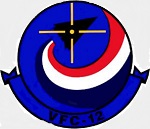Hobby Master HA8903 USN Grumman F4F-4 Wildcat Fighter - 46685, VC-12 "Fighting Omars", USS Core (CVE-13), 1944 (1:48 Scale)
"Skipper, it really worked. I couldn't make any attack without seeing the nose of one of your airplanes pointed at me."
- Ensign Edward "Butch" O'Hare discussing the newly-developed "Thach Weave" maneuver with Lt. Commander John Thach
 The Grumman F4F Wildcat was the standard carrier-based fighter of the United States Navy for the first year and a half of World War II. An improved version built by General Motors (the General Motors FM Wildcat) remained in service throughout the war, on escort carriers where newer, larger and heavier fighters could not be used.
The Grumman F4F Wildcat was the standard carrier-based fighter of the United States Navy for the first year and a half of World War II. An improved version built by General Motors (the General Motors FM Wildcat) remained in service throughout the war, on escort carriers where newer, larger and heavier fighters could not be used.
The Wildcat was outperformed by the Mitsubishi Zero, its major opponent in the Pacific war, but held its own by absorbing far more damage and wielding more firepower. With heavy armor and self-sealing fuel tanks, the Grumman airframe could survive far more than its lightweight, unarmored Japanese rival.
The original Grumman F4F-1 design was a biplane, which when proving inferior to rival designs was recast as the monoplane F4F-2. This was still not competitive with the Brewster F2A Buffalo which won initial US Navy orders, but when the F4F was fitted with a more powerful engine, the Pratt & Whitney Twin Wasp, it showed its true merits and became the F4F-3. US Navy orders followed as did some (with Wright Cyclone engines) from France; these ended up with the Royal Navy's Fleet Air Arm after the fall of France. In British service initially these were known as the Martlet I, but not all Martlets would be to the exact same specifications as US Navy aircraft. The F4F-3A would enter service as the Martlet III(B), the FM-1 as the Martlet V, and the FM-2 as the Martlet VI. The name Wildcat was still commonly used for these aircraft in spite of the official name change.
A new version, the F4F-4, entered service in 1942 with six guns and folding wings, allowing more to be crammed on a carrier; this was the definitive version and the one that saw the most combat service in the early war years including the Battle of Midway.
Grumman production ceased in early 1943 to make way for the newer F6F Hellcat, but General Motors continued producing them for both US Navy and Fleet Air Arm use, as larger fighters such as the Hellcat and the Vought F4U Corsair were too large for use on escort carriers. At first they produced the identical FM-1 model but then switched to the improved FM-2 (based on Grumman's F4F-8 prototype) with a more powerful engine and a taller tail to cope with the torque. In all, 7,251 Wildcats were built.
All versions of the Wildcat used hand-cranked landing gear with a relatively narrow track, making landing accidents where the landing gear were not fully locked into place distressingly common.
Pictured here is a 1:48 scale USN Grumman F4F-4 Wildcat fighter that was attached to VC-12 "Fighting Omars" then embarked upon the USS Core (CVE-13) during 1944.
Sold Out!
Dimensions:
Wingspan: 9-1/2-inches
Length: 7-1/4-inches
Release Date: May 2019
 Historical Account: "Fighting Omars" - The first Composite Squadron Twelve was originally established as VC-12 on October 6th, 1943, at NAS Sand Point, Seattle, Washington. The squadron operated the F4F Wildcat and TBM-1 Avenger aboard USS Card (ACV-11) in the western Pacific until the carrier changed home port to Norfolk, Virginia in 1944. In the Atlantic theater, VC-12 flew combat missions against German U-boats, logging 34 engagements. On June 7th, 1945, VC-12 was disestablished.
Historical Account: "Fighting Omars" - The first Composite Squadron Twelve was originally established as VC-12 on October 6th, 1943, at NAS Sand Point, Seattle, Washington. The squadron operated the F4F Wildcat and TBM-1 Avenger aboard USS Card (ACV-11) in the western Pacific until the carrier changed home port to Norfolk, Virginia in 1944. In the Atlantic theater, VC-12 flew combat missions against German U-boats, logging 34 engagements. On June 7th, 1945, VC-12 was disestablished.


